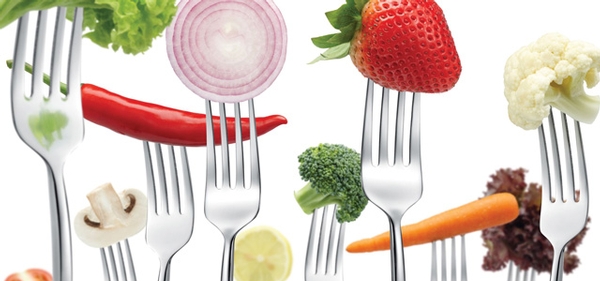To a large extent, modern food safety management efforts in the United States and the rest of the world originated in the 1950s and 1960s with the joint development of the Hazard Analysis and Critical Control Points (HACCP) system of food safety management by The Pillsbury Company, the U.S. Army and NASA.[1] Developed to ensure the safety of military and space foods, the HACCP system was applied to consumer food production beginning in 1972. Its growing success in the global food processing industry for two decades led to its codification in 1992 as the global standard for food safety management by the Codex Alimentarius Commission[2] and the U.S. National Advisory Committee on Microbiological Criteria for Foods.[3,4]
It soon became obvious to its practitioners that the HACCP system could not operate in a vacuum. Food safety defects in several production facilities were found to be related, not to failures at specific CCPs, but rather to failures to recognize the importance of Good Manufacturing Practices (GMPs), also known as Good Hygienic Practices, to prevent the contamination of production line equipment with contaminants from other areas of the production facility. The food industry quickly changed its thinking from “Food safety equals HACCP” to “Food safety equals HACCP plus prerequisite programs.”[5]
Food safety practitioners also recognized that HACCP could not be applied to the production of all foods. Only those foods that could be processed with a CCP—a definitive kill or control step within the control of the food manufacturer—such as pasteurization, sterilization, refrigeration, freezing, dehydration or the reduction of water activity or pH, or the use of preservatives, could reliably be managed by an HACCP system. Foods for which CCPs cannot be developed and applied, those that are typically consumed raw or undercooked, for example, fresh produce or raw ground meat and poultry, can never have the assurance of food safety that resides in those foods produced with one or more CCPs. Therefore, additional prerequisite programs were developed to reduce the chance of food safety failures in foods consumed raw or undercooked.
Good Agricultural Practices (GAPs) were developed to reduce contamination of fruits and vegetables as they were grown, harvested and transported to processing plants or retail distribution centers.[6] Good Distribution Practices (GDP), while in their infancy compared with GAPs and GMPs, are being developed as a necessary part of the farm-to-table spectrum to improve and maintain food safety.[7] The remaining prerequisite program to cover the farm-to-table spectrum, Good Consumer Practices (GCPs), is currently underde-veloped with limited awareness of their benefits.[8,9] Therefore, we are organizing this article to emphasize the importance of consumers’ recognition of their roles and responsibilities to protect their families and themselves, and to remind regulators that food safety requires a steady farm-to-table effort, with sufficient emphasis on the “table” part of this spectrum.
The Case for Consumer Education
The food industry and regulatory agencies have both been reluctant to suggest that consumers bear some responsibility for the safe handling of foods. Moreover, the industry is regularly criticized whenever it suggests that simply cooking raw meat, poultry and seafood properly would easily prevent foodborne illnesses. Industry critics are quick to claim that “just cook it” is used to mask inadequate food safety controls during food processing. We first heard the term “Good Consumer Practices” from an industry executive several years ago. Upon further inquiry, the executive said, “We are not promoting the idea of GCPs because we do not want consumers to think that we are trying to shift our responsibility for food safety to them.”
Neither industry critics nor industry executives are willing to sincerely embrace the concept that ensuring food safety is a farm-to-table responsibility. They probably do not realize that a strong system of food safety management has been developed to achieve the goal of safe food for everyone, with each major part of the farm-to-table supply chain being supported by its own prerequisite program. Food growing and production is supported by GAPs, food processing is supported by GMPs, food distribution is supported by GDPs and food consumption will be supported by GCPs—but only once their efficacy is recognized and accepted.
Furthermore, most participants in the food chain do not realize that HACCP cannot be used to provide safety for a particular food when no CCP is available or practical to develop. They also do not recognize or admit that foods typically consumed raw or undercooked can never be produced completely free of pathogens when the only tools available during their production are GAPs, GMPs and GDPs. For that reason, the development and acceptance of GCPs would significantly reduce the occurrence of foodborne illnesses. Barring acceptance of these facts and responsible actions, the only procedure to reduce foodborne illness associated with raw produce, meat, poultry and seafood would be to cook or irradiate all raw foods at the points of production.
Now the good news! The emerging status of GCPs as an important prerequisite program is not as bleak as the above description might suggest. For some time, governmental organizations, consumer advocacy organizations and determined individuals have laid a solid foundation for GCPs by their steady efforts to educate consumers about safe food handling practices. Several prominent examples are:
• Gateway to Federal Food Safety Information[10]
• Partnership for Food Safety Education[11]
• STOP Foodborne Illness[12]
• Center for Science in the Public Interest[13]
• The Center for Foodborne Illness Research and Prevention[14]
• Food-Safe Kitchens[15]
Clearly, knowledgeable consumers already have access to a great deal of useful information to maintain safe food handling practices in the home. They will be able to do even better with the combined support of governmental agencies, consumer advocacy groups, scientists and other educators, and the companies that grow, process and distribute food. The ultimate acceptance of GCPs as an additional prerequisite program, or “management” practice, will prove to be as useful as the development and acceptance over the past 45 years of GAPs, GMPs and GDPs.
Consumer Attitudes and Practices
Every day, over 316 million people consume some form of food in the United States and are demanding more from the food industry than ever before—through improved nutrition and variety to increasingly “natural” ingredients and increased transparency of the supply chain through improved labeling. Along with these increased demands, the consumer’s confidence in food safety is declining. According to the 2014 Food and Health Survey completed by the International Food Information Council Foundation,[16] over the past 3 years, there has been a 24 percent increase in the number of consumers who are “not too confident” or “not at all confident” in the safety of the U.S. food supply. Perhaps it is this declining confidence in the food supply that has led to increased self-education by the consumer in food safety practices.
Despite the development of a number of educational programs, many consumers do not transfer their knowledge of food safety into action. A recent observational study[17] indicates that essential food safety steps, such as washing hands before preparing food and adequately cooking raw chicken, are not commonly practiced in the home even when the observed individuals claim to be knowledgeable of effective food safety practices! Results from this survey suggest that while consumers believe they are educated in proper food handling and preparation practices, they are not actually applying those principles when cooking in the home. Current food safety education programs are available for educating the general population as a whole. These programs are especially effective as sources of information to those consumers who are interested in food safety and want to become more knowledgeable in safe food handling and effective food preparation. However, we believe there is an opportunity for GCPs to become a program that is complementary to existing educational programs.
It has been demonstrated that knowledge is valuable only if it is transferred into action.[18] The GCP program we are proposing is not designed with the objective of educating consumers, but rather at directing them to take appropriate action. GCPs aim to direct the consumer, in real-time, when the consumer is beginning the preparation of the meal. Very few consumers take the time to access an educational program online or refer to a food safety pamphlet concurrently while cooking ground turkey. And over time, it is by the combination of existing educational programs with consistent, standardized, real-time communication that the safe preparation and handling of food will become learned by consumers by rote.
So what exactly are “Good Consumer Practices” and if the solution is so clear, what could be some of the challenges in their implementation?
We will attempt to answer some of these questions with the summary of a stakeholder analysis completed in 2014. To gain a better understanding of attitudes and perceptions of GCPs by the food industry, a survey was conducted targeting food and ingredient processors (n = 39), food “distributors” (restaurants and grocery stores; n = 6), regulatory officers (n = 6), public health officials (n = 4) and scientists and academics (n = 7). The survey was designed to assess perceptions of a GCP program in the following five areas: 1) who will benefit from a GCP program; 2) expectations and goals of a GCP program; 3) unintended consequences or negative impacts of a GCP program; 4) level of influence over the implementation of a GCP program; and 5) intention to participate in a GCP program, should one be developed.
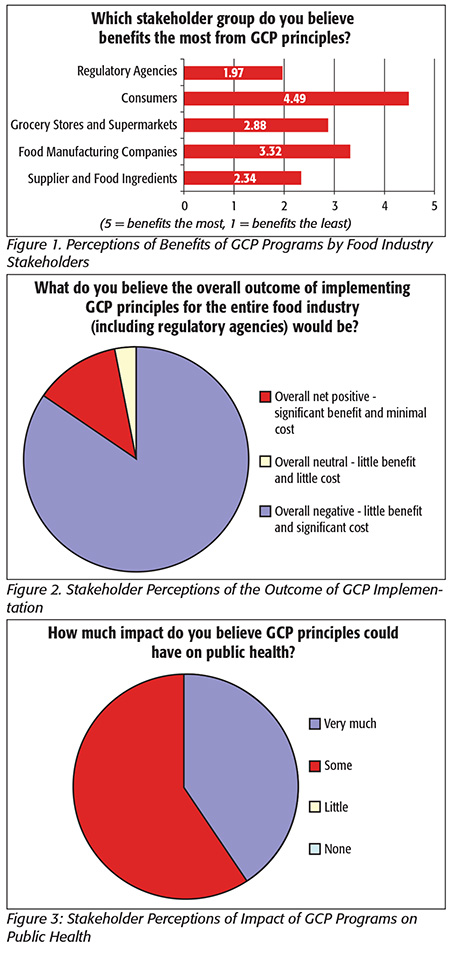 Out of 62 respondents, 98 percent indicated they believe consumers have some responsibility in preparing food safely. Additionally, 84 percent of survey respondents indicated that consumers would benefit the most from a GCP program (followed by suppliers and food manufacturers at 8 percent and 5 percent, respectively). All individuals surveyed indicated that a GCP program would have at least some positive impact on consumer public health. Lastly, 92 percent of survey respondents indicated that they would support the implementation of a GCP program in the food industry (Figures 1–3). While the response to GCPs from representatives of the food industry is largely supportive, the stakeholder analysis did raise some considerations. One of these points that was mentioned by three respondents is the perception that a GCP program could “place the blame” on consumers when foodborne illness occurred. As a result, any GCP program would have to be carefully constructed and mindfully communicated so as not to suggest blame was being placed. Another comment that was received from more than one respondent is that a GCP program shares the food safety responsibility with consumers. Consumers may be wary of why this is the case and so should be a key consideration in designing a GCP program. A second GCP survey, to be submitted exclusively to consumers, has been proposed to gain a better understanding of the perceptions and attitudes of consumers not tied to the food industry.
Out of 62 respondents, 98 percent indicated they believe consumers have some responsibility in preparing food safely. Additionally, 84 percent of survey respondents indicated that consumers would benefit the most from a GCP program (followed by suppliers and food manufacturers at 8 percent and 5 percent, respectively). All individuals surveyed indicated that a GCP program would have at least some positive impact on consumer public health. Lastly, 92 percent of survey respondents indicated that they would support the implementation of a GCP program in the food industry (Figures 1–3). While the response to GCPs from representatives of the food industry is largely supportive, the stakeholder analysis did raise some considerations. One of these points that was mentioned by three respondents is the perception that a GCP program could “place the blame” on consumers when foodborne illness occurred. As a result, any GCP program would have to be carefully constructed and mindfully communicated so as not to suggest blame was being placed. Another comment that was received from more than one respondent is that a GCP program shares the food safety responsibility with consumers. Consumers may be wary of why this is the case and so should be a key consideration in designing a GCP program. A second GCP survey, to be submitted exclusively to consumers, has been proposed to gain a better understanding of the perceptions and attitudes of consumers not tied to the food industry.
Further Development of GCPs
Much work has been done toward the development of safe food preparation and storage practices, as presented by various authors and agencies. Marchiony,[15] Sperber[19] and Kowalcyk[14] provide a solid foundation of practices for consumers to follow to reduce the risk of foodborne illness (Tables 1–3). These practices can easily be segregated into a clean-separate-cook-chill framework that can evolve into an actionable list of GCPs—a sort of “mini-HACCP program” for the kitchen. We will then outline GCP implementation for homes, restaurants, institutions, food/farmers markets and other categories where GCPs apply. Finally, we will discuss our proposal to include GCPs on food labels and briefly visit the current legal perspective on GCPs through a high-level summary of product liability law.

“Ahem!”—Establishing the GCP Framework
“If I walked into the kitchen without washing my hands as a kid, I’d hear a loud ‘Ahem!’ from my mother or grandmother. Now I count on other people to do the same.”
— Maya Angelou
At the highest level, GCPs can be summarized by the following four steps:20 1) Clean, 2) Separate, 3) Cook and 4) Chill. These four steps can be used as an effective outline for keeping consumers safe from foodborne illness. In the following paragraphs, each category will be summarized and presented as a preliminary model for the GCP framework.
Clean
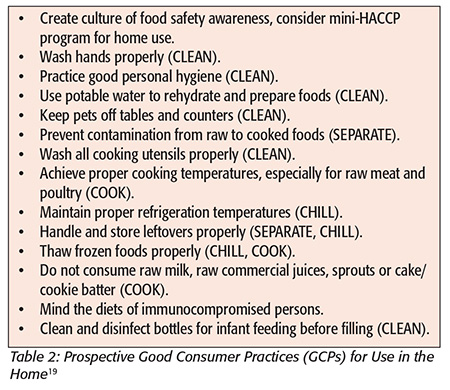 Handwashing. For centuries, washing of the hands has been considered an important and effective hygienic measure.[21] Hand hygiene has since become known as the primary means to prevent contamination of food during handling and preparation. It has been estimated[22] that proper handwashing could reduce the number of deaths associated with diarrhea by nearly 50 percent! The most detailed descriptions of proper handwashing technique15 include using a nail brush, warm water and clean, paper towels (not cloth towels, for fear of microbe harborage). Additionally, guidelines for washing hands published by the U.S. Centers for Disease Control and Prevention[23] indicate that the effective removal of bacteria and viruses is achieved after washing the hands for 20 seconds with warm water and soap.[24-26]
Handwashing. For centuries, washing of the hands has been considered an important and effective hygienic measure.[21] Hand hygiene has since become known as the primary means to prevent contamination of food during handling and preparation. It has been estimated[22] that proper handwashing could reduce the number of deaths associated with diarrhea by nearly 50 percent! The most detailed descriptions of proper handwashing technique15 include using a nail brush, warm water and clean, paper towels (not cloth towels, for fear of microbe harborage). Additionally, guidelines for washing hands published by the U.S. Centers for Disease Control and Prevention[23] indicate that the effective removal of bacteria and viruses is achieved after washing the hands for 20 seconds with warm water and soap.[24-26]
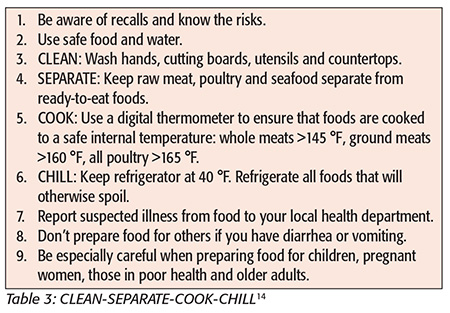
Cleaning and Sanitizing Surfaces. Surfaces (cutting boards, countertops, etc.) should be cleaned and sanitized both before and after they are used for food preparation. Cooking utensils should be cleaned properly following use and either air-dried or dried with a clean, sanitary (preferably paper) towel.
Washing Produce. A detailed review of proper produce washing has been developed.[27] As a general rule, all fruits, root vegetables, tomatoes, cucumbers and bell peppers should be scrubbed prior to consumption. Other produce items such as leafy vegetables, stem vegetables and floral vegetables should not be scrubbed but rather soaked and/or rinsed with potable, cool water for 15 seconds. Prewashed lettuce, spinach and other leafy greens should not be washed again by the consumer as this may contaminate the produce. Prewashed leafy greens should be consumed “as is” without any further washing!
Separate
Raw meat, poultry, seafood and eggs inherently contain some pathogens. By separating these food items (and the surfaces they come into contact with) from ready-to-eat foods, the risk of cross-contamination can be greatly reduced. Different-colored cutting boards have been proposed15 to reduce the risk of cross-contamination during raw food preparation. Another, often-overlooked element of separating foods relates to how and where food items are stored in the refrigerator. Raw meat, poultry and seafood should not be stored above ready-to-eat foods. They should be stored in a condition that will not allow them to drip or cross-contaminate the refrigerator. Plastic containers are best at preventing drips from occurring, but wax-coated or plastic deli paper may also serve this purpose. Raw eggs should also be kept separate from ready-to-eat foods and in a condition that, if an egg were to break, the risk of cross-contamination with other foods is low. Some refrigerators have “egg shelves” with depressions for eggs or a separate bin made specifically for housing eggs in the refrigerator. Either of these is preferable to keeping eggs in the paperboard container they are purchased in. The U.S. Department of Agriculture (USDA) Food Safety and Inspection Service has published a good resource on refrigerator food safety.[28]
Separation of raw meat, poultry, seafood and eggs from ready-to-eat foods is also necessary in the grocery store when consumers place foods in baskets or carts while shopping. Ideally, carts would have a “red” section isolated from the larger section of the cart where raw meats, poultry, seafood and eggs could be placed. Specially marked bags should be used for transporting raw meat, poultry, seafood and eggs. Further research needs to be done to understand the risk of cross-contamination at the point of checkout. Little is published about the sanitary condition of the checkout scanner and conveyor belts.
Are consumers informed of which foods are ready to eat and which foods are not? If this is a component of existing food safety educational material, is this information being retained and applied by the consumer when placing food items in the refrigerator or preparing them to consume? This challenge can be addressed with an updated labeling system as part of the GCP program and will be discussed later in this article.
Cook
Cooking raw foods to an internal temperature to ensure safe consumption is a fundamental GCP. The need for additional rigor around safe cooking temperature practice and communication has been demonstrated. In the before-cited observational study,[17] 40 percent of participants undercooked their chicken. And to further support the “education vs. direction” approach, only 29 percent of participants in the same study knew the USDA-recommended cooked temperature of 165 °F for chicken. It will most likely come as no great surprise that cooking thermometers were not widely used in this study—most participants determined if the chicken was “fully cooked” by physical appearance alone. Not only has it been demonstrated that color and appearance alone are not reliable methods for determining if chicken is safe to eat, but for many other foods, it is almost impossible to determine color change. This is an underlying factor associated with recent ground turkey outbreaks—raw turkey does not have a strong pink color the same way chicken does. Relying on color to cook ground turkey is an extremely ineffective food safety practice. As a culture, we need to improve the expectation that thermometers are used for cooking raw, non-ready-to-eat foods. Thermometer availability in stores, sold near the raw meats and seafood sections, could support this effort significantly.
GCPs for cooking foods should also include a reference to avoiding the consumption of raw cookie dough, raw milk, raw commercial juices, sprouts, “medium-rare” or “rare” cooked ground meats and other often-consumed raw foods that have historical links to foodborne illness.
Chill
The effective chilling of food touches on two main areas: 1) the chilling of raw foods precooking and/or preconsumption and 2) the chilling of food postcooking. Chilling is effective only when the proper temperature and time are followed.
Defrosting Frozen Foods. With less than half of consumers properly thawing meat in the refrigerator prior to cooking,[29] the chilling of foods prior to consumption presents a significant opportunity for consumers to improve food safety. According to the U.S. Food and Drug Administration (FDA), there are three ways to defrost frozen foods: In the refrigerator, in cold water (preferably placing the food in a watertight plastic bag prior to submerging in water) or using a microwave. Defrosting foods at room temperature is not an acceptable practice, as this allows food to sit at temperatures ideal for microbial growth (40 to 140 °F) for a prolonged time. This same principle can be applied to the marinating of meats and fish. Marinating should occur in the refrigerator, not at room temperature, and in a container to avoid leaks and spills.
Refrigerator Temperature. Improper refrigeration temperature is a practice that has room for improvement. FDA has reported that approximately 23 percent of consumers’ refrigerators are not at the recommended temperature of 40 °F or colder. At the very least, refrigerators should have a temperature display easily accessible by the user to facilitate frequent monitoring of temperature. Ideally, consumers should check refrigerator temperatures with an independent thermometer once every 3 months. This GCP could potentially be communicated on a label inside household refrigerators and in the refrigerator manual.
Postcook Chilling. Prepared foods should be refrigerated within 2 hours of eating or preparation. This practice helps avoid the risk of food sitting at room temperature for too long. Additionally, prepared foods that have been chilled for future consumption should be consumed as quickly as possible. Our recommendation is to consume any leftovers within 48 hours from when they were initially prepared.
While the above dialogue focused primarily on GCPs as they apply to the home kitchen, these same food safety principles can be adopted by retail foodservice (e.g., delis and supermarket seafood departments and meat departments) and restaurants, institutions that prepare and serve food (e.g., hospitals, schools, nursing homes), and farmers markets and food stands where food is commonly prepared and served in an outdoor setting. Each of these food preparation environments has its own unique set of challenges and the individual(s) responsible for the preparation of the meals being served needs to be acutely aware of those risk factors that pertain to his or her environment. FDA has published a report entitled FDA Report on the Occurrence of Foodborne Illness Risk Factors in Selected Institutional Foodservice, Restaurant, and Retail Food Store Facility Types.[30] The report calls for the “enhancement” of managerial controls in institutional food preparation around three areas: 1) Improper Holding/Time and Temperature; 2) Poor Personal Hygiene; and 3) Contaminated Equipment/Protection from Contamination. While the FDA Food Code does effectively address most, if not all, of the risk factors associated with retail and foodservice, we believe there is a further opportunity to improve this effort. The formal implementation of a GCP prerequisite program that is linked back to the food manufacturer’s HACCP plan addresses this opportunity. This linkage can be accomplished through clear, standardized, effective labeling, applied by the food manufacturer, that will direct those responsible for preparing foods to practice proper food safety practices.
Enabling the Consumer: Labeling for Food Safety
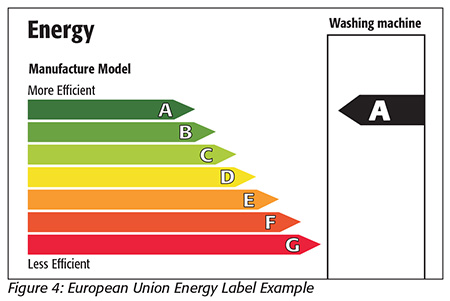 Food labeling in the United States generally aims to achieve one of three objectives: fair competition among food companies, provide the consumer with important information and mitigate risks to consumer safety and health.[31] The final two objectives of food labeling—providing the consumer with important information and the mitigation of safety and health risks—appear to be directly in line with the objectives of our GCP framework. Could GCPs be communicated on the labels of at-risk food items in a standard, easily recognizable (i.e., graphical) format to direct the consumer of the appropriate food safety precaution to take? Other industries have seen success with this approach. The European Union has initiated the European Energy Labeling Directive—a program to label all electronic appliances with the “EU Energy Label” (Figure 4) to inform consumers of the energy efficiency of a particular appliance at the point of purchase. This clear, standardized, graphical communication has generated impressive results, as is demonstrated by refrigerator sales in the European Union over the past 10 years. The average energy efficiency of refrigerators sold improved by 26 percent between 1992 and 1999—with over one-third of the impact being attributable to the use of EU Energy Labels.[32] This labeling program has been so successful because it serves as both a push and pull mechanism for driving energy efficiency. It pushes appliance manufacturers to produce more energy-efficient appliances while the consumers pull (buy) efficient appliances due to the desire to have more cost-effective, environmentally favorable products.
Food labeling in the United States generally aims to achieve one of three objectives: fair competition among food companies, provide the consumer with important information and mitigate risks to consumer safety and health.[31] The final two objectives of food labeling—providing the consumer with important information and the mitigation of safety and health risks—appear to be directly in line with the objectives of our GCP framework. Could GCPs be communicated on the labels of at-risk food items in a standard, easily recognizable (i.e., graphical) format to direct the consumer of the appropriate food safety precaution to take? Other industries have seen success with this approach. The European Union has initiated the European Energy Labeling Directive—a program to label all electronic appliances with the “EU Energy Label” (Figure 4) to inform consumers of the energy efficiency of a particular appliance at the point of purchase. This clear, standardized, graphical communication has generated impressive results, as is demonstrated by refrigerator sales in the European Union over the past 10 years. The average energy efficiency of refrigerators sold improved by 26 percent between 1992 and 1999—with over one-third of the impact being attributable to the use of EU Energy Labels.[32] This labeling program has been so successful because it serves as both a push and pull mechanism for driving energy efficiency. It pushes appliance manufacturers to produce more energy-efficient appliances while the consumers pull (buy) efficient appliances due to the desire to have more cost-effective, environmentally favorable products.
These mechanisms could apply to consumer food safety in a similar, but slightly different manner. Consumers could come to demand foods with a “GCP Label” to protect their own health and the health of their families. This would give those food manufacturers that apply the label a competitive advantage and eventually drive more food manufacturers to its use. While direct, regulatory intervention requiring GCP labeling may ensure a quicker implementation of a GCP Label, one can see how regulatory intervention may not be required to ensure, with time, all at-risk foods sold in the U.S. contain a GCP Label.
As with any new idea, the EU Energy Label program is not without room for improvement, but most of these challenges are due to the comparative nature of the labeling program (lack of differentiation in the A class of products due to numerous products populating this class, for example). By most accounts, the informative element of the EU Energy Label program continues to be a vast success, as demonstrated by the increasing market share of the most energy-efficient models. Further, the success of “front of pack” (FOP) nutrition labeling in the food industry has demonstrated the consumer’s willingness and ability to comprehend labels on foods. A study by the International Food Information Council found that FOP nutrition information “aided with decision making and understanding” by the consumer.[33]
We are currently working with several graphic designers to develop a GCP Label that will effectively communicate the prescribed food safety practice the consumer should follow to ensure food safety. The objectives of a GCP Label will be: to communicate food safety information, applicable to the food item it is affixed to, which is understood by a wide range of consumers; to inspire the consumer to take the appropriate food safety action; and to satisfy the GCP prerequisite program in fulfillment of the manufacturing company’s overall HACCP plan.
It is our aspiration that a completed graphic and label will be adopted by the leading food safety companies in an attempt to pilot the program, gauge consumer response and begin GCP implementation.
Conclusion: Putting the “Table” in “Farm-to-Table”
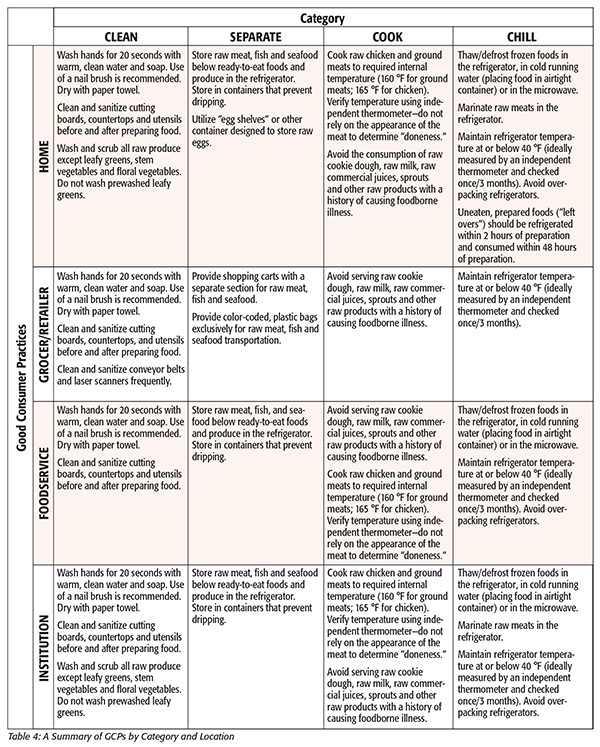 Over the past several years, a number of prerequisite programs have been developed in the realization that traditional CCPs cannot manage the food safety of the “farm-to-table” supply chain alone. These prerequisite programs include GAPs for the farm, GMPs for the manufacturing/processing plant and GDPs for warehousing and distribution. We propose that an additional prerequisite program be developed to address the “table.” This prerequisite program, entitled GCPs, can be linked to the HACCP plan in a manner similar to the other prerequisite programs. Under the GCP program, potentially hazardous foods would be required to be identified via risk assessment and then labeled using a standard, graphical labeling scheme. This label, referred to as a “GCP Label,” highlights the actions the consumer should take to reduce or avoid the risk of the food item causing foodborne illness. These actions or practices (listed in Table 4) will be documented in the manufacturer’s HACCP plan as being communicated to the consumer via a GCP Label. Next steps for this initiative include completion of GCP Label designs, sharing them across the industry and industry working groups to receive feedback and to select the optimal design, and then to pilot the GCP program in partnership with one or more food companies.
Over the past several years, a number of prerequisite programs have been developed in the realization that traditional CCPs cannot manage the food safety of the “farm-to-table” supply chain alone. These prerequisite programs include GAPs for the farm, GMPs for the manufacturing/processing plant and GDPs for warehousing and distribution. We propose that an additional prerequisite program be developed to address the “table.” This prerequisite program, entitled GCPs, can be linked to the HACCP plan in a manner similar to the other prerequisite programs. Under the GCP program, potentially hazardous foods would be required to be identified via risk assessment and then labeled using a standard, graphical labeling scheme. This label, referred to as a “GCP Label,” highlights the actions the consumer should take to reduce or avoid the risk of the food item causing foodborne illness. These actions or practices (listed in Table 4) will be documented in the manufacturer’s HACCP plan as being communicated to the consumer via a GCP Label. Next steps for this initiative include completion of GCP Label designs, sharing them across the industry and industry working groups to receive feedback and to select the optimal design, and then to pilot the GCP program in partnership with one or more food companies.
GCPs admittedly pose a somewhat radical approach in that they place some of the responsibility for safe food on the consumer. They also are based on voluntary labeling by manufacturers and suppliers as opposed to a regulatory requirement. This raises some questions as to where the accountability for the public health (and economic) consequences of unsafe food resides. Some may argue that GCPs bring into question the entire tort liability system, while others may see GCPs as the food industry simply attempting to “pass the buck.” But if protecting public health is the primary objective, these issues become less relevant. The farm-to-table food safety model is a model of shared value, and shared value is being seen as the solution to many challenges in business, economics and politics.34 Together, the food industry and its consumers can continue to advance food safety and protect the health of our friends and families.
Sean Leighton, M.Sc., M.B.A., is director of quality, safety and environmental sustainability for The Coca-Cola Company.
William H. Sperber, Ph.D., completed his education at the University of Wisconsin in 1969 and established himself as a food microbiology and food safety expert during his 43-year career with Best Foods, Pillsbury and Cargill.
References
1. Sperber, WH and RF Stier. 2010. Happy 50th Birthday to HACCP: Retrospective and prospective. Food Safety Magazine 15:42–46.
2. www.codexalimentarius.net/web/more_info.jsp?ic_sta=23.
3. NACMCF. 1992. Hazard analysis and critical control point system. Int. J. Food Microbiol 16:1–23.
4. NACMCF. 1998. Hazard analysis and critical control point principles and application guidelines. J Food Prot 61:762–775.
5. Sperber, WH, et al. 1998. The role of prerequisite programs in managing a HACCP system. Dairy Food Environ Sanitation 18:18–423.
6. www.fao.org/docrep/meeting/006/y8704e.htm.
7. www.steritech.com.
8. Sperber, WH. 2005. HACCP does not work from farm to table. Food Control 16:511–514.
9. Sperber, WH. 2013. Expanding the use of HACCP beyond its traditional application areas. In Advances in Microbial Food Safety, Vol. 1, ed. J. Sofos, 415–432.
10. www.foodsafety.gov.
11. www.fightbac.org.
12. www.stopfoodborneillness.org.
13. www.cspinet.org.
14. www.foodborneillness.org.
15. Marchiony, A. 2004. Food-Safe Kitchens. Upper Saddle River, NJ: Pearson Prentice Hall.
16. www.foodinsight.org/surveys/2014-food-and-health-survey.
17. Bruhn, C. 2011. Observations of consumer salad preparation. Food Protect Trends 31: 274–279.
18. Büssing, A, B Herbig and A Latzl. 2006. Knowledge, experience, action: A new model to analyze their mutual relation. In Knowledge and Action, ed. D Frey, H Mandl and LV Rosenstiel. Cambridge, MA: Hogrefe & Huber Publishers.
19. Sperber, WH. 2011. Food safety in the home: a review and case study. In Food Safety for the 21st Century: Managing HACCP and Food Safety Throughout the Global Supply Chain, ed. CA Wallace, WH Sperber and SE Mortimore. Oxford: Wiley-Blackwell, 303–310.
20. www.foodsafety.gov/keep/basics/index.html.
21. Rotter, M. 1999. Hand washing and hand disinfection. In Hospital Epidemiology and Infection Control, ed. CG Mayhall. Philadelphia: Lippincott Williams & Wilkins.
22. World Health Organization. 2001. Water for Health: Taking Charge.
23. www.cdc.gov/handwashing/.
24. Fuls, JL et al. 2008. Alternative hand contamination technique to compare the activities of antimicrobial and nonantimicrobial soaps under different test conditions. Appl Environ Microbiol 12:3739–3744.
25. Jensen, D et al. 2012. Efficacy of handwashing duration and drying methods. International Association of Food Protection, July.
26. Todd, EC et al. 2010. Outbreaks where food workers have been implicated in the spread of foodborne disease, Part 9, Washing and drying of hands to reduce microbial contamination. J Food Prot 10:1937–1955.
27. Kilonzo-Nthenge, A, FC Chen and SL Godwin. 2006. Efficacy of home washing methods in controlling surface microbial contamination on fresh produce. J Food Prot 69:330–334.
28. www.fsis.usda.gov/shared/PDF/Refrigeration_and_Food_Safety.pdf.
29. FMI Trends, 2009. U.S. Grocery Shopper Trends 2009. Arlington, VA: Research Department, Food Marketing Institute.
30. www.fda.gov/Food/GuidanceRegulation/RetailFoodProtection/FoodborneIllnessRisk
FactorReduction/ucm224321.htm.
31. Hadden, SG. 1986. Read the Label: Reducing Risk by Providing Information. Boulder, CO: Westview Press.
32. CLASP. 2005. Energy-Efficiency Labels and Standards: A Guidebook for Appliances, Equipment and Lighting, 2nd ed. Berkeley, CA: Lawrence Berkeley National Laboratory.
33. www.foodinsight.org/Content/3651/IFIC%20FOP%20SLIDES%20for%20WEB2011.pdf.
34. Porter, M. 2011. Creating shared value. Harvard Business Review Jan.
